Event Detail
Online Conference
Uylupınar (Early Kibyra) Archaeological Survey: From Iron Age Plains to Roman Imperial Highlands of the Kabalis Region…
Associate F. Eray Dökü

Register
The surveys at Uylupınar (Early Kibyra) were carried out between 2012-2021. The research focused on the Kabalis/Kabalia Region, to the southwest of Pisidia, where the people of Kabalia who were of Lydian origin settled and created their own unique culture. The first traces of settlement in the small but fertile plains of Kabalis/Kabalia in [Türkiye’s] Lake District go back to prehistoric times. The number of settlements increased in the Bronze Age. The high concentration of 7-6th century BC ceramic finds on the surface of Bronze Age mounds is worth mentioning. The centre of the survey during this period was the peninsula, known today as “Şehertaşı”, which extends towards Uylupınar/Gölhisar Lake, southeast of the city of Cibyra. With respect to the regional settlement landscape, the mounds were identified on the plains along the main roads, on the foothills and most frequently around the lakes. Similar to the settlement of Düver, Uylupınar (Early Cibyra) in Şehertaşı was founded on a sheltered peninsula by the lake. It offers material cultural data about a settlement that has been inhabited uninterruptedly from the Bronze Age to the Roman Period. Besides ceramic finds, it is important to have discovered hundreds of stone setting tumuli especially as of the beginning of the Late Iron Age in and around Uylupınar (Early Cibyra), on the hills surrounding the settlement. Imported Classical and Hellenistic items are rarely encountered among local cultural productions. The Hellenistic Period must have witnessed an urbanization phase in the region, giving rise to powerful cities such as Cibyra which would eventually give its name to the region. Hellenistic Tetrapolis consisted of the cities of Balboura, Boubon, and Oinoanda as well as Cibyra. In the Roman Imperial Period, Cibyra became a part of the Province of Asia, while other cities politically sided with Lycia. On the other hand, the culture in the countryside is the same. The economy created by the mobile farmer-shepherds, especially in the highlands of the Balboura territory can be traced in archaeological material. The dozens of Zeus, Dioscuri and goddesses, the Theoi Dikaioi/Theoi Agrioi?, Kakasbos and Heracles rock reliefs and the density of open-air sanctuaries found in these high plateaus are worth noting. The rock reliefs are associated with permanent or periodic settlements and road networks. Meanwhile, the lids of the lion sarcophagi typical of rural settlements can still be seen in the high plateaus, defining the region and the way of life.
Start
March 25, 2022 – 19:00
End
March 25, 2022 – 21:00
